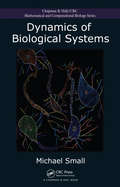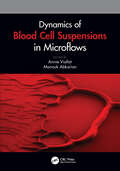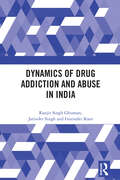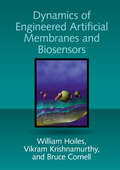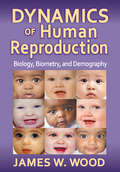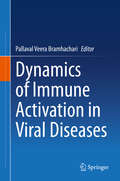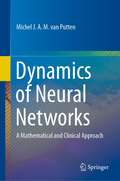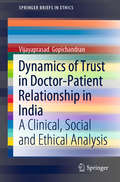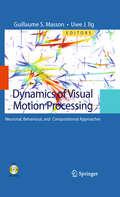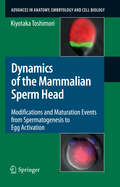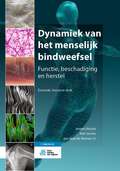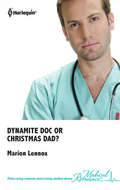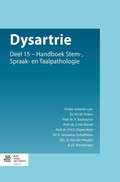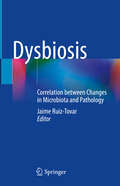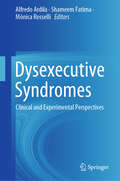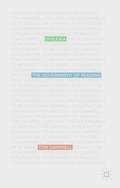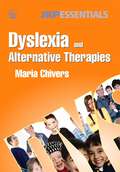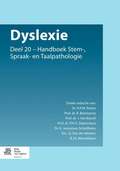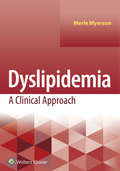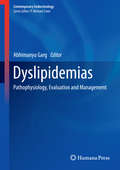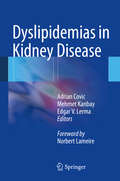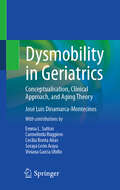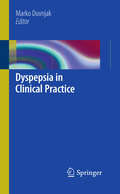- Table View
- List View
Dynamics of Biological Systems (Chapman & Hall/CRC Computational Biology Series)
by Michael SmallFrom the spontaneous rapid firing of cortical neurons to the spatial diffusion of disease epidemics, biological systems exhibit rich dynamic behaviour over a vast range of time and space scales. Unifying many of these diverse phenomena, Dynamics of Biological Systems provides the computational and mathematical platform from which to understand the
Dynamics of Blood Cell Suspensions in Microflows
by Annie Viallat and Manouk AbkarianBlood microcirculation is essential to our bodies for the successful supply of nutrients, waste removal, oxygen delivery, homeostasis, controlling temperature, wound healing, and active immune surveillance. This book provides a physical introduction to the subject and explores how researchers can successfully describe, understand, and predict behaviours of blood flow and blood cells that are directly linked to these important physiological functions. Using practical examples, this book explains how the key concepts of physics are related to blood microcirculation and underlie the dynamic behavior of red blood cells, leukocytes, and platelets. This interdisciplinary book will be a valuable reference for researchers and graduate students in biomechanics, fluid mechanics, biomedical engineering, biological physics, and medicine. Features: The first book to provide a physical perspective of blood microcirculation Draws attention to the potential of this physical approach for novel applications in medicine Edited by specialists in this field, with chapter contributions from subject area specialists
Dynamics of Drug Addiction and Abuse in India
by Jatinder Singh Ranjit Singh Ghuman Gurinder KaurThis book analyzes drug addiction and abuse from the perspectives of the state and community in India, with a special focus on North-West regions of India. India lies in the transit route of two major global centres of heroin and cocaine processing: the Golden Triangle of Myanmar, Thailand and Laos towards the East; and the Golden Crescent of Afghanistan, Iran and Pakistan to the West making it vulnerable to drug trafficking and curbing this has been a tough challenge for enforcement agencies. The book looks at: the nature and pattern of drug addiction across the age groups, gender and occupational groups, both in rural and urban areas in India; the socio-economic causes of drug-use and addiction and the various socio-economic costs associated with it; the general perception of family members, police and political leaders on drug addiction as well as rehabilitation; and available mechanisms to address the issue at the level of family, society and government and the changes required in policy to curb drug addiction and use This interdisciplinary book will be of importance to students and researchers of economics, cultural and social anthropology, sociology, police administration, political science, and psychology. It will also be of interest to policy makers, government agencies, social scientists, departments of social and preventive medicine, social workers, civil society, drug-addicts and their families.
Dynamics of Engineered Artificial Membranes and Biosensors
by Vikram Krishnamurthy William Hoiles Bruce CornellLearn about the state of the art in building artificial membranes and synthetic biological devices, and in constructing mathematical models for their dynamics at multiple time and spatial scales with this comprehensive book. <P><P>Drawing on recent advances in bioengineering and biochemistry, it describes how to engineer tethered bilayer lipid membranes, bioelectronic interfaces, high-resolution biosensors, and diagnostic devices for non-invasive cellular measurements and electroporation. Multi-physics models combining atomistic (molecular dynamics and coarse-grained molecular dynamics), mesoscopic (Poisson–Nernst–Planck), and macroscopic (reaction-rate theory) dynamics provide a complete structure-to-function description of these devices. Experiments and dynamic models explain how anti-microbial peptides penetrate membranes, how molecular machine biosensors built out of artificial membranes can detect femtomolar concentrations, and how electroporation can be controlled. Supported by atomistic simulation code online, this is essential reading for researchers, students and professionals in bioengineering, chemical engineering, biophysics, applied mathematics, and electrical engineering.<P> The first book to provide a comprehensive treatment of artificial membranes: their design, construction, experimental studies, and mathematical models.<P> Includes an introduction to membrane biology and biochemistry.<P> Addresses building and modelling the bioelectronic interface, which is crucial for synthetic biological devices.
Dynamics of Health Care in Society
by Roxann Delaet"Dynamics of Health Care in Society is an introductory textbook derived from key titles in the Lippincott Williams & Wilkins I Wolters Kluwer Health library. Chapters 1 through 20, the appendices, and the glossary are from the textbook: Introduction to Health Care and Careers; Chapter 21 is from the textbook: The Ethical Component of Nursing Education:Integrating Ethics Into Clinical Experience; Chapter 22 stems from the textbook: Nursing in Today's World:Trends, Issues, & Management, Tenth Edition.
Dynamics of Human Reproduction: Biology, Biometry, Demography (Foundations Of Human Behavior Ser.)
by James W. WoodAwarded the W. W. Howells Award for the Outstanding Book in Biological Anthropology, this volume presents a comprehensive, integrated, and up-to-date overview of the major physiological and behavioral factors affecting human reproduction. In attempting to identify the most important causes of variation in fertility within and among human populations, Wood summarizes data from a wide range of societies. Trained as an anthropologist as well as a demographer, he devotes special attention to so-called ""natural fertility"" populations, in which modern contraceptives and induced abortion are not used to limit reproductive output. Such an emphasis enables him to study the interaction of biology and behavior with particular clarity.The volume weaves together the physiological, demographic, and biometric approaches to human fertility in a way that will encourage future interdisciplinary research. Instead of offering a general overview, the focus is to answer one question: Why does fertility and the number of live births vary from couple to couple within any particular population, and from population to population across the human species as a whole?Topics covered include ovarian function, conception and pregnancy, intrauterine mortality, reproductive maturation and senescence, coital frequency and the waiting time to conception, marriage patterns and the initiation of reproduction, the fertility-reducing effects of breastfeeding, the impact of maternal nutrition on reproduction, and reproductive seasonality. This unique combination of comprehensive subject matter and an integrated analytical approach makes the book ideally suited both as a graduate-level textbook and as a reference work.
Dynamics of Immune Activation in Viral Diseases
by Pallaval Veera BramhachariThis book discusses various components of the innate and adaptive immune response in combating viral infections, presenting the recent advances in our understanding of innate immunity recognition of viruses and highlighting the important role of inflammation, cytokines such as interferon, toll-like receptors and leukocytes in the initial detection of invading viruses and subsequent activation of adaptive immunity. It also summarizes the role of the adaptive immunity against viral infections through clearance of virus and establishment of memory response that protects against the recurrent infections. In addition, the book examines the role of DNA and RNA sensors in viral recognition and in controlling viral infection. Lastly, it reviews the latest developments in the development of the rational viral vaccines. As such it is a useful resource book for postgraduate and early researchers wanting to gain insights into the immune response to viral infections.
Dynamics of Neural Networks: A Mathematical and Clinical Approach
by Michel J.A.M. van PuttenThis book treats essentials from neurophysiology (Hodgkin–Huxley equations, synaptic transmission, prototype networks of neurons) and related mathematical concepts (dimensionality reductions, equilibria, bifurcations, limit cycles and phase plane analysis). This is subsequently applied in a clinical context, focusing on EEG generation, ischaemia, epilepsy and neurostimulation. The book is based on a graduate course taught by clinicians and mathematicians at the Institute of Technical Medicine at the University of Twente. Throughout the text, the author presents examples of neurological disorders in relation to applied mathematics to assist in disclosing various fundamental properties of the clinical reality at hand. Exercises are provided at the end of each chapter; answers are included. Basic knowledge of calculus, linear algebra, differential equations and familiarity with MATLAB or Python is assumed. Also, students should have some understanding of essentials of (clinical) neurophysiology, although most concepts are summarized in the first chapters. The audience includes advanced undergraduate or graduate students in Biomedical Engineering, Technical Medicine and Biology. Applied mathematicians may find pleasure in learning about the neurophysiology and clinic essentials applications. In addition, clinicians with an interest in dynamics of neural networks may find this book useful, too.
Dynamics of Trust in Doctor-Patient Relationship in India: A Clinical, Social and Ethical Analysis (SpringerBriefs in Ethics)
by Vijayaprasad GopichandranThis book offers an easy-to-read, yet comprehensive introduction to practical issues in doctor–patient relationships in a typical low- and middle-income country setting in India, examining in detail the reasons for erosion of trust and providing guidance on potential research areas in the field. It strikes a balance between empirical work and theoretical normative analysis, while adopting mixed-method research in exploring important constructs in the doctor–patient relationship, such as trust, solidarity, advocacy, patient-centeredness, privacy, and confidentiality. Since the concept of trust has direct implications for the ethical practice of medicine, the book is a valuable resource for academics and researchers in the field of medical, clinical, and applied ethics.
Dynamics of Visual Motion Processing
by Guillaume S. Masson Uwe J. IlgMotion processing is an essential piece of the complex brain machinery that allows us to reconstruct the 3D layout of objects in the environment, to break camouflage, to perform scene segmentation, to estimate the ego movement, and to control our action. Although motion perception and its neural basis have been a topic of intensive research and modeling the last two decades, recent experimental evidences have stressed the dynamical aspects of motion integration and segmentation. This book presents the most recent approaches that have changed our view of biological motion processing. These new experimental evidences call for new models emphasizing the collective dynamics of large population of neurons rather than the properties of separate individual filters. Chapters will stress how the dynamics of motion processing can be used as a general approach to understand the brain dynamics itself.
Dynamics of the Mammalian Sperm Head
by Kiyotaka ToshimoriMammalian spermatozoa have complex structures. The structure-function relationship of sperm has been studied from various viewpoints. Accumulated evidence has shown that the sperm components undergo sequential changes from the beginning of spermatogenesis to the time of fertilization/embryogenesis. Structural analyses have been performed using various new techniques of light and electron microscopy as well as immunohistochemistry and immunocytochemistry in combination with specific probes such as antibodies against sperm components. Recently developed gene-manipulation techniques have accelerated investigations on the events that govern the relationship between the structure and molecular components of sperm. In addition, animal models with gene manipulations have been shown to exhibit various morphological and functional abnormalities that lead to infertility. In this book, I discuss the events that occur in the normal sperm head and govern the structure-function relationship from the time of spermatogenesis to that of fertilization or egg activation. In this regard, I describe dynamic modifications and maturation events occurring in sperm-head components and compare the outcomes of these events with the outcomes of their failure.
Dynamiek van het menselijk bindweefsel: Functie, beschadiging en herstel
by Jeroen Alessie Karl Jacobs Jan Jaap de MorreeDit boek biedt een functionele beschrijving van verschillende typen bindweefsels en vertaalt die naar kennis over lichamelijke belasting, beschadiging en herstel. Het is bedoeld voor studenten fysiotherapie, bewegingstherapie, manuele therapie, ergonomie en kinesitherapie aan hogescholen en universiteiten. Ook voor professionals is het een handig naslagwerk. De eerste versie van Dynamiek van het menselijk bindweefsel verscheen 30 jaar geleden. Deze zevende druk is inhoudelijk ingrijpend gewijzigd, op basis van nieuwe inzichten en recent onderzoek naar bindweefsel. En dan met name op het gebied van de anatomie en de rol van het fasciale systeem als kracht-geleidend en proprioceptief systeem. Hoofdstuk 2 gaat nu in op de embryologische ontwikkeling van bindweefsel en hoofdstuk 9 staat volledig in het teken van de diverse functies van het fasciale systeem. Ook zijn nieuwe foto’s toegevoegd ter illustratie van spier-, pees-, en fasciaweefsel. Dynamiek van het menselijk bindweefsel is een goed aanknopingspunt om de juiste vorm van therapie te kunnen bepalen. Het laatste hoofdstuk helpt daar expliciet bij, daarin staan overwegingen om de therapeutische interventie te ondersteunen. Dynamiek van het menselijk bindweefsel heeft een nieuwe auteursteam. Jeroen Alessie is hogeschooldocent fysiotherapie. Ook is hij is coauteur van paramedische studieboeken. Karl Jacobs is voormalig fysiotherapeut, studeerde Functional and Clinical Anatomy en is als anatoom verbonden aan het Amsterdam UMC. Beide auteurs zijn ervaren sprekers op congressen en betrokken bij diverse bij- en nascholingen.
Dynamite Doc or Christmas Dad?
by Marion LennoxExtract from Dusty's diary, age 10I've never had a proper family Christmas. It's always just been me and my mum, Jess. But now I've met my cool uncle Ben. He's a doctor, just like my mum. I didn't know him until recently, but now I'm starting to know what it's like to have a dad around. Uncle Ben makes mum smile, and I even caught them kissing, but when I told her she blushed!As soon as Christmas is over, we're going home. But if I'm a really good boy, maybe Uncle Ben might want to come back, too?
Dysartrie: Deel 15 - Handboek Stem-, Spraak- en Taalpathologie
by H.F.M Peters R. Bastiaanse J. Borsel P.H.O. Dejonckere K. Jansonius-Schultheiss Sj. Meulen B.J.E. MondelaersHet Handboek Stem-Spraak-Taalpathologie verscheen tussen 1997 en 2007 gefaseerd in losse afleveringen. Daarin werd alle kennis op het gebied van de stem-, spraak- en taalpathologie vanuit verschillende disciplines samengebracht. Het Handboek is bestemd voor iedereen die klinisch-praktisch of meer theoretisch is geïnteresseerd, of vanuit een ander vakgebied hiermee in aanraking komt. Voor logopedisten, artsen, linguïsten, spraak- en taalpathologen, audiologen, pedagogen en psychologen in Nederland en België is het Handboek een onmisbare vraagbaak.Deel 15 gaat over dysartrie en beschrijft een casus van een meisje met een achterste schedelgroeve-tumor met cerebellaire dysartrie en een Parkinsonpatiënt met een hypokinetische dysartrie.
Dysbiosis: Correlation between Changes in Microbiota and Pathology
by Jaime Ruiz-TovarThis book discusses in detail the pathological aspects associated with alterations in the gut microbiota and the pathogenesis of different disorders related to dysbiosis. The volume describes the impact of dysbiosis on organs other than the gut and brain, such as metabolic diseases, cancer, gynecologic disorders, aging, or pediatric pathologies. Additionally, it associates the mechanisms and metabolic signaling pathways related to gut microbiota homeostasis and alterations with their clinical impact, highlighting the importance of translational research on dysbiosis.The volume is divided into 12 chapters: the first two chapters present diagnostic methods and therapeutic options, including prebiotics and probiotics. The remaining ten chapters specifically focus on diseases of different organs. Moreover, the relevance of these findings to precision medicine will be discussed. The book provides biomedical professionals, basic researchers, and clinical practitioners, especially those specialized in Precision Medicine and Integrative Medicine, with information about the effects of dysbiosis on the physiopathology of various diseases. It also includes updated evidence on the impact of dysbiosis on numerous pathologies, such as metabolic diseases, cancer, gynecologic disorders, aging, or pediatric pathologies, going beyond gastrointestinal and central nervous system diseases typically covered in many publications.Furthermore, the book addresses the translational aspect of dysbiosis. It starts with the basic research knowledge on dysbiosis and disease and aims to provide a translational approach applicable to clinical practice. By combining the fundamental knowledge of biomedical researchers with the clinical applicability of healthcare practitioners, this book bridges the gap between theory and practice.
Dysexecutive Syndromes: Clinical and Experimental Perspectives
by Alfredo Ardila Mónica Rosselli Shameem FatimaThe concept of executive functioning has become central in understanding normal and abnormal cognitive processes. This timely volume analyzes the diverse conditions that can result in executive function disturbances, providing research about underlying causes, exploring the differences between developmental and acquired executive "dysfunctions," and providing approaches for the assessment of executive dysfunction both in children and in adults. In doing so, it addresses a gap in the literature in its analysis of executive function deficits and their link with psychopathology in psychiatric patients for the management of clinical symptoms and social adjustment.Among the specific topics examined: Theoretical approaches for the analysis of the diverse dysexecutive syndromes Common executive dysfunction syndromes found during childhood development: attention deficit hyperactivity disorder and autism spectrum disorders Consequences of executive function deficits in the use of information technology Executive dysfunction and personality disorders Common executive function tests, assessment issues in executive dysfunction, and cross-cultural and bilingual questions in assessment of executive dysfunction Dysexecutive Syndromes: Clinical and Experimental Perspectives expertly extends the analysis of executive functions and dysfunctions from a fundamental and clinical perspective. It is essential reading for clinical psychologists, neuropsychologists, neurologists, and psychiatrists, and graduate and post-graduate students in psychology, neurology, and the health neurosciences, as well as clinicians, counselors, and psychometricians working with neuropsychiatric assessment.
Dyslexia
by Tom CampbellThe diagnosis of 'Dyslexia' and the medical problematisation of reading difficulties were almost unknown one hundred years ago, yet today the British Dyslexia Association estimates that up to ten per cent of the UK population may have some form of dyslexia, with numbers in the United States estimated to be as high as twenty per cent. The Government of Reading investigates how this problematisation developed and how a diagnostic category was shaped in response to this.
Dyslexia and Alternative Therapies
by Maria Chivers'A good book about how alternative therapies can help dyslexia. It mentions each therapy individually and explains what it is, how it works, how many sessions are needed, who will benefit, and if it can be done at home.' - Education Otherwise This comprehensive book offers clear and balanced information on a range of alternative therapies for individuals with dyslexia, dyscalculia, dyspraxia or ADHD. The author provides an overview of each therapeutic option, method of use and case examples, covering nutritional supplements, massage, acupuncture and hypnotherapy, among others. She also includes contributions from experienced alternative therapists, offering an insider's view of what works and what does not. Her objective approach will enable the reader to make an informed choice from among the many available options. A bibliography and a list of useful contacts are also provided. This book is a key resource for anyone interested in exploring alternative therapy approaches to dyslexia and related difficulties, particularly for parents of people with dyslexia, dyslexics themselves and the professionals who work with them.
Dyslexia, Reading and the Brain: A Sourcebook of Psychological and Biological Research
by Alan BeatonDespite the wealth of literature available on the subject of dyslexia, there is little that explores the subject beyond a single theoretical framework. The need for a comprehensive review of the literature by both researchers and practitioners from different fields and theoretical backgrounds is the central motivation behind Dyslexia, Reading and the Brain. By combining the existing fragmented and one-sided accounts, Alan Beaton has created a sourcebook that provides the much-needed basis for a more integrated and holistic approach to dyslexia.The book is divided into two sections: the first, The Cognitive Context, outlines the theoretical context of normal reading development and introduces the role of phonological awareness and the relation between dyslexia and IQ. Section two, The Biological Context, provides an explanation of the genetic background as well as exploring hormonal theories and the visual aspects of dyslexia.
Dyslexie
by R. Bastiaanse P.H.O. Dejonckere K. Jansonius-Schultheiss B.J.E. Mondelaers H.F.M. Peters J. Van Borsel Sj. Van der MeulenHet Handboek Stem-Spraak-Taalpathologie verscheen tussen 1997 en 2007 gefaseerd in losse afleveringen. Daarin werd alle kennis op het gebied van de stem-, spraak- en taalpathologie vanuit verschillende disciplines samengebracht. Het Handboek is bestemd voor iedereen die klinisch-praktisch of meer theoretisch is geïnteresseerd, of vanuit een ander vakgebied hiermee in aanraking komt. Voor logopedisten, artsen, linguïsten, spraak- en taalpathologen, audiologen, pedagogen en psychologen in Nederland en België is het Handboek een onmisbare vraagbaak.Deel 20 is geheel gewijd aan dyslexie.
Dyslipidemia: A Clinical Approach
by Merle MyersonAn ideal reference for practitioners and health care professionals who care for patients with abnormal lipids, Dyslipidemia: A Clinical Approach provides clinically relevant, user-friendly information on all aspects of this rapidly evolving field. In addition to concise yet in-depth coverage of key topics, chapters include background information, evidence from the literature, and author commentary on conflicting or debated recommendations. Written by respected leaders in cardiology, nutrition, pharmacology, endocrinology and diabetes, pediatrics, nursing, obstetrics and gynecology, and lipidology, this one-stop reference is an excellent resource for helping patients lower the burden of atherosclerotic lipid particles and reduce the risk for cardiovascular disease.
Dyslipidemias
by Abhimanyu GargDyslipidemias: Pathophysiology, Evaluation and Management provides a wealth of general and detailed guidelines for the clinical evaluation and management of lipid disorders in adults and children. Covering the full range of common through rare lipid disorders, this timely resource offers targeted, practical information for all clinicians who care for patients with dyslipidemias, including general internists, pediatric and adult endocrinologists, pediatricians, lipidologists, cardiologists, internists, and geneticists. For the last twenty years, there has been a growing recognition worldwide of the importance of managing dyslipidemia for the primary and secondary prevention of atherosclerotic vascular disease, especially coronary heart disease. This has been mainly due to the publication of the guidelines of National Cholesterol Education Program's Adult Treatment Panel and Pediatric Panel from the United States. These guidelines have stimulated generation of similar recommendations from all over the world, particularly Europe, Canada, Australia and Asia. Developed by a renowned group of leading international experts, the book offers state-of-the-art chapters that are peer-reviewed and represent a comprehensive assessment of the field. A major addition to the literature, Dyslipidemias: Pathophysiology, Evaluation and Management is a gold-standard level reference for all clinicians who are challenged to provide the best care and new opportunities for patients with dyslipidemias.
Dyslipidemias in Kidney Disease
by Edgar V. Lerma Adrian Covic Mehmet KanbayDyslipidemia in chronic kidney disease is a common clinical problem and growing in prevalence. With the recent publication of clinical practice guidelines on the management of lipid related disorders in patients affected by chronic kidney disease, an up-to-date and comprehensive resource of evidence-based literature is needed. Dyslipidemias in Kidney Disease captures the growing body of information on this subject matter. This book presents the latest clinical evidence and management guidance for patients of various demographics and stages of chronic kidney disease. Written for the nephrologist community, as well as cardiologists and general practitioners, this guide will provide practical knowledge and fill a much needed void in the literature.
Dysmobility in Geriatrics: Conceptualisation, Clinical Approach, and Aging Theory
by José Luis Dinamarca-MontecinosThis book proposes a way of understanding human movement and its forms of deterioration and preservation in older people. The author presents a method to diagnose motor problems, to implement effective both preventive and therapeutic measures, and to compare the results with those of other clinicians and health centres. It is a conceptual and practical book at the same time. From the redefinition of the classic geriatric syndrome of Immobility, a concept of deep clinical interest is developed: Dysmobility. Moreover, a specially developed methodology is delivered to maximise the benefits for the patient, clinicians, and caregivers. Both the concepts and the methodology are discussed in a clear, precise, and practical manner to be applied in the daily clinical practice in Geriatrics. Dysmobility is defined in its three diagnostic axes, including the official updated version of D-STAGING (known as ETADI in Spanish), the motor continuum staging that revolutionised the clinic with its advent. Additionally, the requirements and criteria necessary for its correct application and use are explained conceptually step by step, and practically with clinical cases. Along with this, the new possibilities that arise from this conceptualisation and methodology are addressed, particularly in the field of comparative medicine and clinical research. Finally, the bases of a new theory of aging, the Movement-Time theory or theory of Dysmobility, are presented. This work will support physicians from different medical specialties, such as geriatricians, physiatrists, family doctors, geriatric dentists, and health professionals from the interdisciplinary team like gerontologists, nurses, kinesiologists/physiotherapists, psychologists, speech therapists, occupational therapists, nutritionists and social workers. It will also be of interest to students of health-related professions, resident physicians for different specialties, and researchers in mobility and rehabilitation.
Dyspepsia in Clinical Practice
by Marko DuvnjakAlthough dyspepsia has been investigated for a long period of time, there is no international agreement on what constitutes this condition nor any standardized guidelines. National guidelines followed by practitioners in different countries vary in diagnostic and therapeutic approach, underlining the necessity for a unique definition worldwide. Dyspepsia in Clinical Practice summarizes the current guidelines while offering a unified, practical definition of dyspepsia, and a diagnostic algorithm with an emphasis on the upper gastrointestinal endoscopy and rational first-line therapeutic approach based on epidemiology, pathophysiology, clinical presentation, diagnostic workup and response to previous therapy. Up-to-date scientific information about dyspepsia is presented from a practical, clinician's point of view. Written by experts in the field, this volume addresses dyspepsia in childhood and in the elderly, a very important issue often insufficiently emphasized in the literature. Guidelines are provided that can be easily followed in clinical practice, leading to a reduction in costs and increased patient safety. Dyspepsia in Clinical Practice will be of great value to gastroenterologists, internists, primary care physicians, pediatricians, infectious disease specialists, residents and fellows in training.
